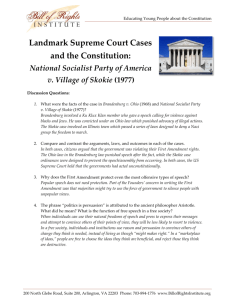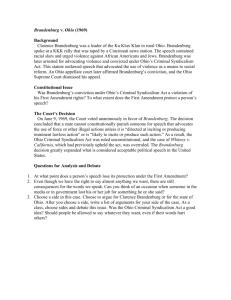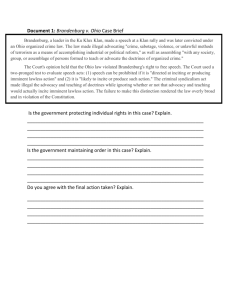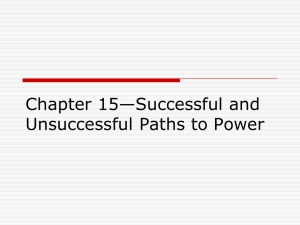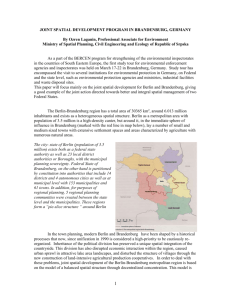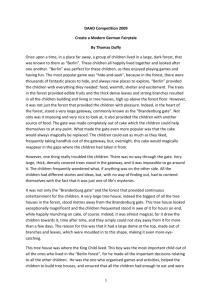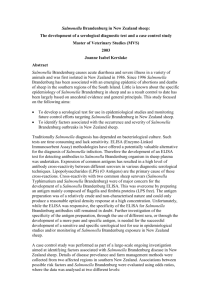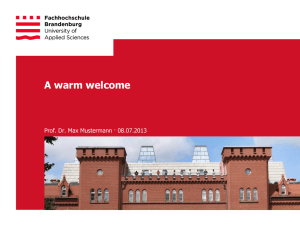brandenburg: then and now
advertisement
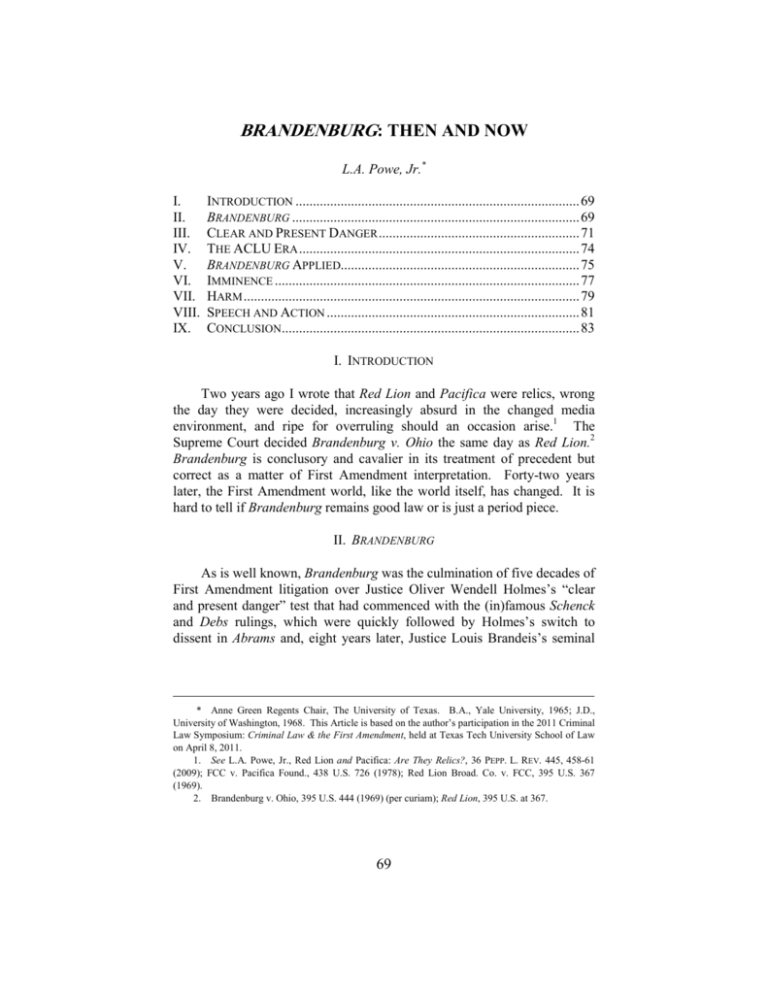
BRANDENBURG: THEN AND NOW L.A. Powe, Jr.* I. II. III. IV. V. VI. VII. VIII. IX. INTRODUCTION .................................................................................. 69 BRANDENBURG ................................................................................... 69 CLEAR AND PRESENT DANGER .......................................................... 71 THE ACLU ERA ................................................................................. 74 BRANDENBURG APPLIED..................................................................... 75 IMMINENCE ........................................................................................ 77 HARM ................................................................................................. 79 SPEECH AND ACTION ......................................................................... 81 CONCLUSION...................................................................................... 83 I. INTRODUCTION Two years ago I wrote that Red Lion and Pacifica were relics, wrong the day they were decided, increasingly absurd in the changed media environment, and ripe for overruling should an occasion arise.1 The Supreme Court decided Brandenburg v. Ohio the same day as Red Lion.2 Brandenburg is conclusory and cavalier in its treatment of precedent but correct as a matter of First Amendment interpretation. Forty-two years later, the First Amendment world, like the world itself, has changed. It is hard to tell if Brandenburg remains good law or is just a period piece. II. BRANDENBURG As is well known, Brandenburg was the culmination of five decades of First Amendment litigation over Justice Oliver Wendell Holmes’s “clear and present danger” test that had commenced with the (in)famous Schenck and Debs rulings, which were quickly followed by Holmes’s switch to dissent in Abrams and, eight years later, Justice Louis Brandeis’s seminal * Anne Green Regents Chair, The University of Texas. B.A., Yale University, 1965; J.D., University of Washington, 1968. This Article is based on the author’s participation in the 2011 Criminal Law Symposium: Criminal Law & the First Amendment, held at Texas Tech University School of Law on April 8, 2011. 1. See L.A. Powe, Jr., Red Lion and Pacifica: Are They Relics?, 36 PEPP. L. REV. 445, 458-61 (2009); FCC v. Pacifica Found., 438 U.S. 726 (1978); Red Lion Broad. Co. v. FCC, 395 U.S. 367 (1969). 2. Brandenburg v. Ohio, 395 U.S. 444 (1969) (per curiam); Red Lion, 395 U.S. at 367. 69 70 TEXAS TECH LAW REVIEW [Vol. 44:69 separate opinion in Whitney.3 The First Amendment story has often been told as a whiggish tale of progress, with Dennis creating a brief interruption, corrected six years later.4 In fact, there was a decade of major interruption that culminated in sustaining the loyalty−security programs from constitutional challenge in 1961, with the Court poised to allow a southern state to use communist-hunting tactics against the National Association for the Advancement of Colored People (NAACP).5 It took personnel changes and the Civil Rights Movement to set the stage for Brandenburg.6 The Ohio Criminal Syndicalism Act (Ohio Act), dating from the end of World War I, was quite similar to the act that the Court sustained in Whitney.7 In contrast, Brandenburg claimed that: [Subsequent decisions had] fashioned the principle that the constitutional guarantees of free speech and free press do not permit a State to forbid or proscribe advocacy of the use of force or of law violation except where such advocacy is directed to inciting or producing imminent lawless action 8 and is likely to incite or produce such action. The Ohio Act reached advocacy as well as incitement; thus, it was unconstitutional.9 Whitney was expressly overruled.10 The Brandenburg test thus required incitement and imminence on the one hand, or advocacy resulting in violence on the other.11 The incitement standard had been articulated as a matter of Smith Act statutory interpretation twelve years earlier in Yates.12 As Gerald Gunther soon pointed out, the Smith Act dated from Learned Hand’s World War I opinion 3. Whitney v. California, 274 U.S. 357, 372-80 (1927) (Brandies, J., concurring), overruled by Brandenburg, 395 U.S. at 449; Abrams v. United States, 250 U.S. 616, 624-31 (1919) (Holmes, J., dissenting); Debs v. United States, 249 U.S. 211 (1919); Schenck v. United States, 249 U.S. 47 (1919); see Frank R. Strong, Fifty Years of “Clear and Present Danger”: From Schenck to Brandenburg—and Beyond, 1969 SUP. CT. REV. 41, 42 (1969). 4. Dennis v. United States, 341 U.S. 494 (1951); see HARRY KALVEN, JR., A WORTHY TRADITION 190-210 (Jamie Kalven ed., 1988); GEOFFREY R. STONE, PERILOUS TIMES 395-98 (2004). 5. See LUCAS A. POWE, JR., THE WARREN COURT AND AMERICAN POLITICS 147-56 (2000). The hiatus paralleled the story of supposed continuous American constitutional development, which itself had a huge interruption that commenced in 1861. See STONE, supra note 4, at 80-85. 6. See generally BRUCE ALLEN MURPHY, FORTAS: THE RISE AND RUIN OF A SUPREME COURT JUSTICE 187-94, 527-43 (1988) (discussing changes of Associate Justices in the Supreme Court). Arthur Goldberg replaced Justice Frankfurter, and later, Abe Fortas replaced Arthur Goldberg as an Associate Justice. See id. 7. See Brandenburg, 395 U.S. at 447; Whitney, 274 U.S. at 359-60. Both statutes discuss criminal syndicalism as advocacy, violence, or unlawful methods/acts conducted by a person for purposes of political reform. See Brandenburg, 395 U.S. at 447. 8. Brandenburg, 395 U.S. at 447. 9. See id. at 448. 10. Id. at 449. 11. See id. at 448. 12. See Yates v. United States, 354 U.S. 298, 313-20 (1957). 2011] BRANDENBURG: THEN AND NOW 71 in Masses Publishing.13 Incitement was tied to imminence because it was impossible to incite someone to action at some unspecified future moment.14 Thus, imminence becomes the key because violence must happen now.15 It is possible to believe that if the violence did not happen then it was not imminent, and the speech was probably not that likely to cause violence.16 But that would undercut the alternative: advocacy causing violence.17 If taken seriously, the Brandenburg test solved the constitutional issue present since Schenck by implicitly holding that all the cases that upheld convictions were wrongly decided.18 The only problem with such an interpretation is that the Court cited Dennis favorably even though the test articulated only the requirement that the possibility of attempted overthrow of the government at some unspecified later date when conditions were ripe outweigh the minimal intrusion on free speech.19 Furthermore, Brandenburg quoted Noto v. United States on the advocacy−incitement distinction without noting that in a companion case, Scales v. United States, the defendant went to jail.20 That is what I meant when I stated that Brandenburg was cavalier in its treatment of precedent.21 It started as an opinion by Abe Fortas, but when Fortas resigned under pressure, William Brennan molded it into a per curiam decision.22 Both Justices cared far more about results than any need for reasoning.23 III. CLEAR AND PRESENT DANGER Because Dennis was accurately perceived as gutting the clear and present danger test, academic commentators had given up on the test by the time of Brandenburg.24 The central fact of the pre-Brandenburg test was that if the speaker’s advocacy was likely to persuade the listener to act 13. See Masses Publ’g Co. v. Patten, 244 F. 535 (S.D.N.Y. 1917), rev’d, 246 F. 24 (2d Cir. 1917); Gerald Gunther, Learned Hand and the Origins of Modern First Amendment Doctrine: Some Fragments of History, 27 STAN. L. REV. 719, 720 (1975). 14. See Brandenburg, 395 U.S. at 447. Try imagining Vince Lombardi inciting his 1963 Packers to beat the Bears in 1965. 15. See KALVEN, supra note 4, at 215-19. 16. See Brandenburg, 395 U.S. at 456-57 (Douglas, J., concurring). 17. See id. 18. See KALVEN, supra note 4, at 231, 234. 19. See id.; Brandenburg, 395 U.S. at 447-78; Dennis v. United States, 341 U.S. 494, 499-501 (1951). 20. See Brandenburg, 395 U.S. at 448 (quoting Noto v. United States, 367 U.S. 290, 297-98 (1961)); Scales v. United States, 367 U.S. 203, 259 (1961). 21. See supra Part I. 22. See MURPHY, supra note 6, at 544, 669 n.63. His law clerk, Martha Field, wrote it over a weekend. 23. See POWE, supra note 5, at 202, 304; LAURA KALMAN, ABE FORTAS: A BIOGRAPHY 271-72 (1990); SETH STERN & STEPHEN WERMIEL, JUSTICE BRENNAN: LIBERAL CHAMPION 190 (2010). 24. See KALVEN, supra note 4, at 209-10. 72 TEXAS TECH LAW REVIEW [Vol. 44:69 illegally, then the state had the right to silence the speaker.25 Thomas Emerson caustically observed that “[t]o permit the state to cut off expression as soon as it comes close to being effective is essentially to allow only abstract or innocuous expression.”26 Harry Kalven saw the test as an “outmoded idea,” noting that “whatever sense it may have made in the limited context in which it originated” has passed, as it “is clumsy and artificial.”27 Thus, “the decline in its fortunes under the Warren Court seems to be an intellectual gain.”28 Speaking more generally, Robert McCloskey noted that by 1965, “almost no one seems to believe that this formula can be very helpful in deciding concrete cases.”29 McCloskey was right.30 Emerson and Kalven represented liberals signaling their displeasure with the test.31 Conservatives had already abandoned it.32 Writing before Dennis, Paul Freund asserted that: [N]o matter how rapidly we utter the phrase “clear and present danger,” or how closely we hyphenate the words, they are not a substitute for the weighing of values. They tend to convey a delusion of certitude when what is most certain is the complexity of the strands in the web of 33 freedoms which the judge must disentangle. Felix Frankfurter put it succinctly in his Dennis concurrence: Cases should be decided “by candid and informed weighing of the competing interests.”34 Completing the Harvard attack on clear and present danger, Learned Hand, whose gutting of the test had been embraced by Chief Justice Fred Vinson in Dennis, was blunt: “I cannot help thinking that for once Homer nodded.”35 Kalven was heartened not only by the absence of the clear and present danger test in the Court’s opinions, but also by the change in First Amendment litigants.36 Throughout the fifties, but ending in 1961, the dominant First Amendment claimants were communists or those thought to be communists.37 Thereafter, they were replaced by civil rights 25. See Brandenburg, 395 U.S. at 448-49. 26. Thomas I. Emerson, Toward a General Theory of the First Amendment, 72 YALE L.J. 877, 911 (1963). 27. Harry Kalven Jr., “Uninhibited, Robust, and Wide-Open”—A Note on Free Speech and the Warren Court, 67 MICH. L. REV. 289, 297 (1968). 28. Id. 29. Robert McCloskey, Reflections on the Warren Court, 51 VA. L. REV. 1229, 1236 (1965). 30. See Strong, supra note 3, at 43-60. 31. See id. 32. See id. 33. PAUL FREUND, ON UNDERSTANDING THE SUPREME COURT 27-28 (1949). 34. Dennis v. United States, 341 U.S. 494, 525 (1951) (Frankfurter, J., concurring). 35. LEARNED HAND, THE BILL OF RIGHTS 59 (1958). 36. HARRY KALVEN, JR., THE NEGRO AND THE FIRST AMENDMENT 65-66 (Phoenix ed. Univ. of Chi. Press 1966) (1965). 37. See id. at 71-74. 2011] BRANDENBURG: THEN AND NOW 73 demonstrators (or the NAACP itself).38 The Court might have wanted to do more to end the McCarthyite repression than it was able to do, but the Court was not going to succumb to segregationists.39 The attorney for Montgomery Police Commissioner (and ardent segregationist) L. B. Sullivan, who had prevailed in a $500,000 libel action against the New York Times, crowed that “[t]he only way the Court could decide against me was to change one hundred years or more of libel law.”40 But as I observed, “[g]iven Brown, the NAACP saga, and the fact that the Court needed allies, changing a century of libel law to protect the northern press was a small task, much smaller than that of the segregation or reapportionment cases.”41 The key pre-Brandenburg case was the first Vietnam protest case, Bond v. Floyd.42 Julian Bond and five other African-Americans became the first blacks to win election to the Georgia legislature since Reconstruction.43 Bond was the best known of the six.44 He was the communications director of the Student Nonviolent Coordinating Committee (SNCC)—the most aggressive of the civil rights organizations.45 Between his election and the time the legislature met, the SNCC issued a statement opposing the Vietnam War and supporting draft resisters.46 Bond endorsed the statement but walked away slightly by stating that he was a pacifist and he had never counseled burning a draft card.47 The legislature refused to seat him on the ground that he could not in good faith take the oath to support the state and federal constitutions.48 The other five African-Americans were seated without objection.49 Chief Justice Earl Warren’s opinion for a unanimous Court was long on facts and short on reasoning.50 Finding no incitement to violate any law, the Court followed with: “No useful purpose would be served by discussing the many decisions of this Court which establish that Bond could not have been convicted for these statements consistently with the First Amendment.”51 The problem with the statement was the three cases cited had nothing to do with the constitutional issue; instead, they involved 38. 39. 40. 41. 42. 43. 44. See id. at 65-67, 81-82. See id. at 115-16. POWE, supra note 5, at 307. Id. See Bond v. Floyd, 385 U.S. 116, 118 (1965). See id. See The Election of Julian Bond: 1966-1967, AFRICAN-AMERICAN INVOLVEMENT IN THE VIETNAM WAR, http://www.aavw.org/protest/bond_election_abstract04.html (last visited Sept. 14, 2011). 45. See Bond, 385 U.S. at 118 n.39. 46. See id. at 119-20. 47. See id. at 121, 124. 48. See id. at 125. 49. See The Election of Julian Bond, supra note 44. 50. See Bond, 385 U.S. at 118. 51. Id. at 134. 74 TEXAS TECH LAW REVIEW [Vol. 44:69 contempt by publication,52 statutory construction of the Smith Act,53 and hostile audiences.54 Bond had been questioning a war and verbally supporting draft resistance during a time of (undeclared) war.55 Seemingly, the relevant cases would have been from World War I, specifically Debs and Frohwerk, a companion case to Schenck.56 After Bond, it was clear that the World War I cases where the clear and present danger test made its debut and the government always prevailed were no longer good law.57 The way had been cleared for Brandenburg. IV. THE ACLU ERA Brandenburg was not alone in signaling the new era of the First Amendment. In cases involving obscenity, offensive speech, and national security injunctions, the Court issued opinions that looked as if the American Civil Liberties Union had first cleared them.58 Just two months before Brandenburg, the Court decided Stanley v. Georgia, a case involving stag films where the materials were certainly obscene under whatever the confused applicable law was.59 Justice Thurgood Marshall’s opinion for the Court left the rationales for regulating obscenity in shambles because, for the first time, a majority treated an obscenity case as if it were a true First Amendment case.60 That is, the Court demanded that the State assert and then prove its justifications for censoring the material.61 Georgia offered the mandatory twin interests of obscenity regulation: protecting against impure thoughts and minimizing the risks of anti-social behavior.62 Both failed, and the Court recognized a private right to possess obscene materials.63 Like Bond v. Floyd, Cohen v. California was an antiwar case—one that escalated the protest.64 Paul Cohen entered a Los Angeles courthouse wearing a jacket emblazoned on the back with the message “Fuck the 52. See Wood v. Georgia, 370 U.S. 375, 367 (1962). 53. See Yates v. United States, 354 U.S. 298, 300 (1957). 54. See Terminiello v. Chicago, 337 U.S. 1, 2 (1949). 55. See Bond, 385 U.S. at 118-21. 56. Debs v. United States, 249 U.S. 211 (1919); Frohwerk v. United States, 249 U.S. 204 (1919); Schenck v. United States, 249 U.S. 47 (1919). 57. See generally Bond, 385 U.S. at 136 (citing N.Y. Times Co. v. Sullivan, 376 U.S. 254, 270 (1964)) (stating that debate on public issues should be open and uninhibited). 58. See Cohen v. California, 403 U.S. 15, 16 (1971) (offensive speech); N.Y. Times Co. v. United States, 403 U.S. 713, 725 (1971) (per curiam) (national security injunction); Stanley v. Georgia, 394 U.S. 557, 558 (1969) (obscenity). 59. See Stanley, 394 U.S. at 558. 60. See id. at 563-65. 61. Id. at 565. 62. Id. at 565-67. 63. Id. at 568. 64. Cohen v. California, 403 U.S. 15 (1971); Bond v. Floyd, 385 U.S. 116 (1965). 2011] BRANDENBURG: THEN AND NOW 75 Draft.”65 At the time, “fuck” was a runaway winner as the single most offensive word in the American vocabulary.66 Furthermore, justices are likely to believe courthouses are special, and it is undeniable that some people must be in the courthouse whether or not they wish to be.67 Nevertheless, the Court protected Cohen’s message.68 The Pentagon Papers Case, decided three weeks after Cohen, involved the largest national-security breach (pre-WikiLeaks) in American history—forty-seven volumes of classified documents on the Vietnam War.69 After two installments appeared in the New York Times, the Nixon Administration sought and received a temporary restraining order prohibiting further publication of the material, and it took the Court’s decision to free the press.70 Although no one involved on the Government’s side read all the Pentagon Papers, the Government claimed, and courts agreed, that publication would prolong the war (Daniel Ellsberg, the leaker, wrongly assumed it would shorten the war).71 Judge Malcomb Wilkey on the D.C. Circuit stated that publication “could clearly result in great harm to the nation[,] . . . the death of soldiers, the destruction of alliances, the greatly increased difficulty of negotiation with our enemies, [and] the inability of our diplomats to negotiate.”72 The key word was “could.” An injunction against publication—a prior restraint—went to the core of freedom of the press.73 The Government has a very heavy burden of proof to justify an injunction, and the majority of the Court concluded that the burden was not met.74 Thus, Brandenburg was neither alone nor an outlier. It was part of a larger project—creating the most speech-protective doctrine possible. V. BRANDENBURG APPLIED Looking at Brandenburg, and the future in 1969, one would not have guessed that advocacy of illegal action would only come to the Court twice in the next four decades, but that has turned out to be the case. In both Hess v. Indiana, decided in 1973, and NAACP v. Clairborne Hardware Co., 65. Cohen, 403 U.S. at 16. 66. See id. at 25 (describing the word as being “more distasteful than most”). 67. See id. at 21-22. 68. See id. at 26. 69. N.Y. Times Co. v. United States, 403 U.S. 713 (1971) (per curiam). 70. Id. 71. Id. at 763. 72. United States v. Wash. Post Co., 446 F.2d 1327, 1330 (D.C. Cir. 1971) (Wilkey, J., dissenting), aff’d sub nom., N.Y. Times Co., 403 U.S. 713 (1971) (per curiam). 73. Id. at 1332. 74. N.Y. Times Co., 403 U.S. at 714. 76 TEXAS TECH LAW REVIEW [Vol. 44:69 decided nine years later, the Court reversed a penalty for advocacy of illegal action.75 An antiwar protest at Indiana University wound up blocking a public street.76 When verbal orders from the sheriff to clear the street failed, the sheriff and deputies cleared it themselves.77 Hess, who was standing off the street, loudly stated as the sheriff passed him, “We’ll take the fucking street again.”78 Witnesses stated he was not exhorting the crowd to go back into the street.79 Hess was convicted of disorderly conduct.80 The Court tersely reversed the conviction, stating: “At best, however, the statement could be taken as counsel for present moderation; at worst, it amounted to nothing more than advocacy of illegal action at some indefinite future time.”81 Lacking immediacy or actual law-breaking, the statement was protected under Brandenburg.82 Claiborne Hardware was the more difficult case; although unlike Hess, it was unanimous.83 The reasons for unanimity appear to be two-fold: First, it came from Mississippi; and second, it was the last case from the Civil Rights Era.84 In 1966 the NAACP and local civil rights leaders organized a boycott of white merchants in Port Gibson, Mississippi, and its surrounding county.85 The boycott lasted seven years and was backed up by both persuasion and intimidation.86 Enforcers, called “Black Hats,” stood outside stores and took down names.87 Those African-Americans who patronized white merchants had their names published and read aloud during meetings.88 There was some violence.89 On two occasions, shots were fired into a house; on another, a brick was thrown through a windshield.90 In a speech, Charles Evers “stated that boycott violators would be ‘disciplined’ by their own people and warned that the Sheriff could not sleep with boycott violators at night.”91 Two days later in another speech, he stated: “If we catch any of you going in any of them racist stores, 75. NAACP v. Claiborne Hardware Co., 458 U.S. 886, 934 (1982); Hess v. Indiana, 414 U.S. 105, 109 (1973) (per curiam). 76. Hess, 414 U.S. at 106. 77. Id. 78. Id. at 107. 79. Id. 80. Id. at 105. 81. Id. at 108-09. 82. Id. 83. NAACP v. Claiborne Hardware Co., 458 U.S. 886 (1982). 84. Id. 85. Id. at 889. 86. Id. at 920. 87. Id. at 903. 88. Id. at 903-04. 89. See id. at 922. 90. Id. at 904. 91. Id. at 902. 2011] BRANDENBURG: THEN AND NOW 77 we’re gonna break your damn neck.”92 The Mississippi courts imposed civil liability on the NAACP and Evers, but the Supreme Court reversed, finding the boycott was protected activity.93 The Court stated, “The emotionally charged rhetoric of Charles Evers’[s] speeches did not transcend the bounds of protected speech set forth in Brandenburg.”94 The violence occurred weeks or months after his speeches, and there was no evidence that he “authorized, ratified, or directly threatened acts of violence.”95 Is there an explanation for the paucity of cases involving Brandenburg? One explanation could be that prosecutors became reluctant to bring cases because of the unlikelihood of ultimate success. But I doubt this. A more likely explanation is that the 1960s ended, and with their end came the end to the turbulent times that produced Bond, Cohen, the Pentagon Papers Case, Hess, and Claiborne Hardware.96 Invasions of Grenada, Panama, the first Gulf War, the overthrow of the Taliban, and even the overthrow of the Iraqi dictatorship did not create significant unrest at home. It was not that history ended so much as Americans were disinterested, and then after 9/11, Americans were sufficiently unquestioning so that a large antiwar movement did not come into existence. The answer, I suspect, is the lack of a draft. If all Americans had to sacrifice to sustain a war footing, then I suspect there would have been more opportunities to test Brandenburg. VI. IMMINENCE There appear to be a handful of possible scenarios that could bring Brandenburg into play: (1) an Iman in an American mosque preaching jihad via suicide bombings against Americans; (2) someone calling for the killing of Muslims in retaliation for, say, the ground-zero mosque; (3) someone calling for the killing of abortion providers or married gays because they are an affront to the speaker’s god. For these purposes I am going to assume no specific individual is mentioned by name and that the speaker has a following. Let’s stipulate that violence is likely (even though it may not occur). The constitutional issue will turn on imminence.97 I have always taught imminence as being “pretty damn soon,” possibly referencing Brandeis’s perhaps outmoded idea of whether there is time for speech to rebut 92. Id. 93. Id. at 934. 94. Id. at 928. 95. Id. at 929. 96. But, ironically, the times do not seem to fit with the Ku Klux Klan in Ohio, the facts of Brandenburg. 97. See Brandenburg v. Ohio, 395 U.S. 444, 447 (1969) (per curiam). 78 TEXAS TECH LAW REVIEW [Vol. 44:69 speech.98 If my teaching has been correct, imminence is probably a matter of hours, or stretching, a few days. My interpretation is supported by Claiborne Hardware, where the Court noted the violence occurred weeks or months after Evers’s speeches.99 Justice Stephen Breyer weighed in on Brandenburg three times (pushing his new book) in two days in September 2010.100 With George Stephanopoulos, Breyer was asked about the kookie Florida pastor who threatened to burn the Quran on 9/11.101 Breyer went back to Holmes to note that you can’t “shout fire in a crowded theater” because people could be trampled to death.102 Leaving aside that he badly mangled Holmes, Breyer suggested that because of the Internet, messages can spread to the whole world and people could be killed (presumably by outraged Muslims).103 He implied that the First Amendment requires a debate or conversation (which hardly seems present on the Internet) and that cases like the Quran burning “force people [he meant Justices] to think carefully.”104 In the afternoon with Terry Gross, Breyer still misquoted Holmes, but now he was in a balancing mode, recognizing that it was constitutional to burn the American flag.105 Between flag burning, which merely offends people, and an action that leads to the killing of people, he stated, “I’ve given you an outline, which sort of sets boundaries.”106 A day later, with Larry King, Breyer acknowledged that there was a right to burn the Quran.107 We protect “expression that we hate.”108 Breyer’s statement to Terry Gross may be telegraphing something. Burning a flag offends people.109 There was property damage in Claiborne Hardware, but no one was physically hurt.110 Breyer, however, may be hinting that imminence might be tied to the expected harm in the form of a 98. See Whitney v. California, 274 U.S. 357, 377 (1927) (Brandeis, J., concurring), overruled by Brandenburg, 395 U.S. 444. 99. Claiborne Hardware Co., 458 U.S. at 928. 100. See Good Morning America (ABC television broadcast Sept. 14, 2010), available at 2010 WLNR 18257747 (transcript); Fresh Air (NPR radio broadcast Sept. 14, 2010), available at 2010 WLNR 18257824 (transcript); Larry King Live (CNN television broadcast Sept. 15, 2010), available at 2010 WLNR 18326799 (transcript); see also STEPHEN BREYER, MAKING OUR DEMOCRACY WORK (2010). 101. See Good Morning America, supra note 100. 102. See id. 103. See id. Breyer omitted the key word “falsely” and added “crowded.” See id. It is a common mistake, but one a Supreme Court Justice should not make. See id.; see also L.A. Powe, Jr., Searching for the False Shout of “Fire,” 19 CONST. COMMENT. 345 (2002) (discussing origins of Holmes’s famous quote). 104. Good Morning America, supra note 100. 105. See Fresh Air, supra note 100; Texas v. Johnson, 491 U.S. 397 (1989). 106. Fresh Air, supra note 100. 107. Larry King Live, supra note 100. 108. Id. 109. See Johnson, 491 U.S. at 408. 110. NAACP v. Claiborne Hardware Co., 458 U.S. 886, 928 (1982). 2011] BRANDENBURG: THEN AND NOW 79 balancing test like that advocated by Freund and Frankfurter in their critique of clear and present danger.111 The greater the harm, the longer it is imminent, and if it occurs, then Brandenburg’s “producing” comes into play regardless of imminence. VII. HARM With this as a possibility, consider the Court’s decisions so far discussed. The threat to social stability was always overblown.112 Indeed, this is a major component of First Amendment jurisprudence.113 The government always overestimates the harm that speech will cause to society.114 Start with Schenck and Debs.115 Both were convicted of conspiracy to obstruct the draft and cause insubordination of the armed forces.116 Schenck mailed an antiwar, antidraft letter to draft-age men.117 There is not a shred of evidence that it was effective.118 It is worse in Debs’s case, as he delivered an outdoor speech in Canton, Ohio, praising socialism and expressing admiration for three socialists imprisoned for obstructing the draft, as well as telling people they were “fit for something better than slavery and cannon fodder.”119 There was no evidence that there were any draft-eligible men or members of the armed services in the audience.120 Abrams is similar.121 The call for the general strike went unheeded.122 If we fast forward to the Cold War, it is apparent that the Soviet Union was a threat to the United States. But domestic communists were not.123 Justice William O. Douglas got it precisely right in his Dennis dissent: Communism in the world scene is no bogey-man; but Communism as a political faction or party in this country plainly is. Communism has been so thoroughly exposed in this country that it has been crippled as a political force. Free speech has destroyed it as an effective political party. It is inconceivable that those who went up and down this country 111. See supra notes 33-34 and accompanying text. 112. Brandenburg v. Ohio, 395 U.S. 444, 454 (per curiam) (Douglas, J., concurring) (stating that the threats examined were “always puny and made serious only by judges” (emphasis added)). 113. See Geoffrey R. Stone, Free Speech in the Twenty-first Century: The Lessons of the Twentieth Century, 36 PEPP. L. REV. 273, 278 (2009) (discussing times of panic). 114. See supra note 112. 115. Schenck v. United States, 249 U.S. 47 (1919); Debs v. United States, 249 U.S. 211 (1919). 116. Schenck, 249 U.S. at 48-49; Debs, 249 U.S. at 212. 117. Schenck, 249 U.S. at 50. 118. See id. at 49. 119. Debs, 249 U.S. at 214. 120. David Ray Papke, Eugene Debs as Legal Heretic: The Law-Related Conversion, Catechism, and Evangelism of an American Socialist, 53 U. CIN. L. REV. 339, 364 (1994). 121. Abrams v. United States, 250 U.S. 616 (1919). 122. See id. at 628 (Holmes, J., dissenting) (arguing that no danger was posed by the “silly leaflet”). 123. Dennis v. United States, 341 U.S. 494, 588 (1951) (Douglas, J., dissenting). 80 TEXAS TECH LAW REVIEW [Vol. 44:69 preaching the doctrine of revolution which petitioners expouse would have any success. In days of trouble and confusion, when bread lines were long, when the unemployed walked the streets, when people were starving, the advocates of a short-cut by revolution might have a chance to gain adherents. But today there are no such conditions. The country is not in despair; the people know Soviet Communism; the doctrine of Soviet revolution is exposed in all of its ugliness and the American people want 124 none of it. In a terse conclusion, he stated that the majority “might as well say that the speech of petitioners is outlawed because Soviet Russia and her Red Army are a threat to world peace.”125 In Bond, the SNCC’s antiwar statement, while prescient, was not going to undermine a then-still-popular war. Perhaps having an articulate, handsome African-American in the legislature might undermine Georgia’s segregation, but the Court had long since signed on to that war. Nor was Cohen’s message, although it may have been part of the long-term coarsening of public discourse.126 Hess was never involved in another antiwar rally that spilled over into the streets and blocked traffic.127 Only the Pentagon Papers Case appeared to have presented a real risk, and we now know that never came to fruition.128 Brandenburg itself was a Ku Klux Klan “rally” at a farm in southern Ohio.129 There were a dozen hooded figures, some with guns, gathering around a wooden cross that they burned.130 No one was there except the participants, plus an invited reporter and his cameraman.131 The Klan may be a threat to African-Americans (and Jews, who Brandenburg also mentioned), but that is because of the Klan’s existence, not because of Brandenburg’s rant.132 But a true verbal threat would be different because the Court is not ever going to hold that actual threats constitute protected speech. Watts v. United States was decided six weeks prior to Brandenburg.133 Watts had just received his order to report for a pre-induction physical.134 At an antiwar rally in D.C., he said he would not report for induction, and if he got a gun, “the first man [he would] want to get in [his] sights [was] L.B.J.” because shooting him would be better than shooting Watts’s “black 124. 125. 126. 127. 128. 129. 130. 131. 132. 133. 134. Id. Id. at 587-88. See supra notes 64-68 and accompanying text. See supra notes 75-82 and accompanying text. See N.Y. Times Co. v. United States, 403 U.S. 713 (1971) (per curiam). Brandenburg v. Ohio, 395 U.S. 444, 445 (1969) (per curiam). Id. Id. at 445-46. Id. at 446. Watts v. United States, 394 U.S. 705 (1969). Id. at 706. 2011] BRANDENBURG: THEN AND NOW 81 brothers” in Vietnam.135 The majority reversed his conviction for threatening the life of the President.136 The statute itself was constitutional, but Watts’s ramblings were just crude hyperbole and not a real threat.137 Similarly, in Claiborne Hardware, the Court interpreted the evidence for itself.138 It noted the “emotionally charged rhetoric” of Evers when he stated that anyone caught in the racist stores would get a broken neck.139 But it concluded that he had not “authorized, ratified, or directly threatened acts of violence.”140 However questionable that conclusion looks on the record, when the Court held his speeches “did not transcend the bounds of . . . Brandenburg,” it implied that true threats are not outside Brandenburg.141 “Clearly, threats . . . however communicated are proscribed under the First Amendment.”142 It is the government’s job to worry about the security of the American people. But the Bill of Rights sets limits on how it conducts that job, and just as history teaches us that censors censor, it also teaches that governments overstate risks. VIII. SPEECH AND ACTION How will it be possible to know when a government is not overstating the risks from an inflammatory speech? Justice Douglas opened his great Dennis dissent with an acknowledgement that the First Amendment was not absolute, and that if certain things could be proven, he would support conviction of the communist leaders: If this were a case where those who claimed protection under the First Amendment were teaching the techniques of sabotage, the assassination of the President, the filching of documents from public files, the planting of bombs, the art of street warfare, and the like, I would have no doubts. . . . [T]he teaching of methods of terror and other seditious conduct should be 143 beyond the pale . . . . Justice Douglas returned to the theme twenty years later in a case involving the New York criminal-anarchy law that had been involved in Gitlow and whose counterpart had been declared unconstitutional in 135. Id. 136. Id. at 708. 137. See id. 138. See NAACP v. Claiborne Hardware Co., 458 U.S. 902, 928 (1982). 139. Id. 140. Id. at 929. 141. Id. at 928. Consider substituting the Klan, which is enforcing a boycott of black merchants through intimidation with the identical amount of violence as Claiborne Hardware, for the NAACP. Would the result be the same? 142. Madsen v. Women’s Health Ctr., 512 U.S. 753, 773 (1994). 143. Dennis v. United States, 341 U.S. 494, 581 (1951) (Douglas, J., dissenting). 82 TEXAS TECH LAW REVIEW [Vol. 44:69 Brandenburg.144 Rather than vote to dismiss the indictment, he noted that “while some of the counts embrace only advocacy or acts which fall within [Brandenburg’s] penumbra, still others are in the field of activities far removed from the protection of the First Amendment[:] . . . the acquisition of weapons, gunpowder, and the like, and the storing of gasoline to start fires.”145 Harkening back to the two treason prosecutions for aiding the Nazis during World War II, the New Deal Court drew a line between simply meeting the Nazi saboteurs and offering shelter, purchasing a car, and finding a job in a defense facility.146 Four justices, including both Justice Black and Justice Douglas, rejected that distinction, and there is the possibility that the distinction might apply solely to treason cases because of the historic aversion to using this crime without incontrovertible proof.147 Then last year in Holder v. Humanitarian Law Project, the Court upheld a federal law that prohibits providing material aid to terrorist groups.148 The Humanitarian Law Project (Law Project) wished to help designated terrorist groups learn to use the law to peacefully settle disputes, to petition the United Nations, and to better advocate on their own behalf.149 The Court held the Law Project was free to advocate on behalf of terrorist organizations but could not coordinate with them (as each of the items would require doing).150 What neither the majority nor the dissent stated was that the Law Project could advocate that the terrorist groups continue killing civilians until their goals were met. Yet that advocacy falls within the protection of Brandenburg.151 These cases suggest that if the incendiary speaker has personal contact with the ultimate perpetrator of violence, it may, and probably should be, sufficient to tie him in with the action. Suggesting training or specific victims or a specific place for the attack, if provable, would cement the case. In Justice Douglas’s words, there would be speech plus action.152 If this were the case, then First Amendment concerns would vanish. 144. See Samuels v. Mackell, 401 U.S. 66, 74-75 (1971) (Douglas, J., concurring). 145. Id. at 75. 146. Compare Cramer v. United States, 325 U.S. 1, 36, 48 (1945) (holding that merely meeting and conversing with Nazi saboteurs did not constitute overt acts sufficient to support a conviction for treason), with Haupt v. United States, 330 U.S. 631, 644-45 (1947) (holding that a father’s acts of sheltering and harboring his saboteur son and assisting him in purchasing an automobile and obtaining employment constituted overt acts sufficient to support a conviction for treason). 147. See Cramer, 325 U.S. at 48 (Douglas, J., dissenting). 148. Holder v. Humanitarian Law Project, 130 S. Ct. 2705, 2731 (2010). 149. See id. at 2720. 150. See id. at 2730-31. 151. See Brandenburg v. Ohio, 395 U.S. 444, 449 (1969) (per curiam). 152. See Dennis v. United States, 341 U.S. 494, 584 (1951) (Douglas J., dissenting). 2011] BRANDENBURG: THEN AND NOW 83 IX. CONCLUSION Where does Brandenburg stand? I have suggested several possible modern readings of the case, some truer to 1969, some less so, but that is to be expected. The strictest interpretation of Brandenburg is that of Justice Douglas with his emphasis on either unlawful conduct or very specific instruction on the method of violent action.153 It may well be that future cases will restrict speech “brigaded with illegal action” and thus remove any need to consider limits of the First Amendment.154 While this might prove the most likely factual scenario, as a legal matter, Justice Douglas could not prevail at the height of American liberalism, so it is most unlikely that his formulation could prevail in the foreseeable future. Possibly the easiest interpretation of Brandenburg would be to accept the case as written, thereby focusing attention on imminence. I cannot help but think a Court might respond: “That’s so pre-9/11.” More likely is some form of a Breyer-like balancing test. Justice Breyer is a product of the Harvard Law School that was dominated by Frankfurter’s philosophy, and Justice Breyer’s allusion to balancing may be a throwback. So it is well to remember that the supposedly sophisticated Harvard balancers, represented on the Court by Justice Frankfurter and Justice John Marshall Harlan, really did not balance at all. They always ruled for the government no matter how weak the government interest or how strong that of the individual was.155 Balancing, as practiced, simply negated the First Amendment. Finally, and most relevantly, Schenck, Abrams, Dennis, Bond, and Brandenburg were all products of their times.156 They reflected the views of well-informed elites about the threats to society and how to accommodate them to the Constitution. There is no reason to believe a future Court will behave differently. Holder v. Humanitarian Law Project offers more than a hint.157 The majority did not even think it necessary to cite Brandenburg.158 153. See supra Part V. 154. Roth v. United States, 354 U.S. 476, 514 (1957) (Douglas, J., dissenting) (“Freedom of expression can be suppressed if, and to the extent that, it is so closely brigaded with illegal action as to be an inseparable part of it.”). 155. POWE, supra note 5, at 154. 156. Brandenburg v. Ohio, 395 U.S. 444 (1969) (per curiam); Bond v. Floyd, 385 U.S. 116 (1965); Dennis v. United States, 341 U.S. 494 (1957); Abrams v. United States, 250 U.S. 616 (1919); Schenck v. United States, 249 U.S. 47 (1919). 157. See Holder v. Humanitarian Law Project, 130 S. Ct. 2705 (2010). 158. See id. The dissent offered the imminence quote and then stated the obvious: “No one contends that the plaintiffs’ speech to these organizations can be prohibited as incitement under Brandenburg.” See id. at 2733 (Breyer, J., dissenting). But that was it.
